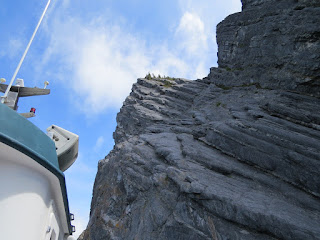As we continued ever north to make our scheduled
ferry trip to Labrador, we stopped briefly in Gros Morne National park. This massive park is best known for its
geological history. The Long Range mountains were formed over a billion years
ago. What makes this area unique is
the strange rock formations that were
formed by the pressure of the plate tectonics.
In fact, it was here that geologists were able to prove the plate tectonics
theory. The tablelands mountain is a
striking example of this with its flat top material having come from deep
inside the earth.
First we
visited Lobster Cove Head Light, where one family lived in the lighthouse and
tended it for over a 100 years. The
lighthouse itself was undergoing a refit, but the guide brought the place to
life for us. The scenic views of the
surrounding area alone made the visit worthwhile.
Then a quick stop in the town of Rocky Harbor for
lunch.
Finally, we took a boat ride to observe these tectonic plates and the long history they represent. Millions of years ago, many of these plates were
pushed to the surface in a nearly vertical position. Those who study these plates have learned a great deal about the history of the earth in this park. We
were also able to enjoy the scenic beauty of the park and surrounding villages
from the water.






































































